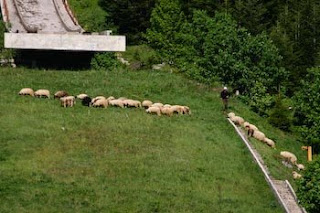Early Saturday morning, I took a personal tour
 to the mountains outside of Sarajevo, site of the 1984 Winter Olympics. My guide, just 12 years old when the war started, drove me the 25 km southeast of the city. At an overlook, we stopped to enjoy the mountainous view. Birds were chirping, some purple wildflowers poked their way out of the weeds, and everything seemed so peaceful. In the distance we saw a mountain that had remnants of snow – where one of the Olympic venues were held. Below us was the village of Dejčući. Farmers were bent over in the fields, working by hand. The village, with its stone barns and weathered wooden fences, reminded me of some Serbian villages, except that this one had a mosque.
to the mountains outside of Sarajevo, site of the 1984 Winter Olympics. My guide, just 12 years old when the war started, drove me the 25 km southeast of the city. At an overlook, we stopped to enjoy the mountainous view. Birds were chirping, some purple wildflowers poked their way out of the weeds, and everything seemed so peaceful. In the distance we saw a mountain that had remnants of snow – where one of the Olympic venues were held. Below us was the village of Dejčući. Farmers were bent over in the fields, working by hand. The village, with its stone barns and weathered wooden fences, reminded me of some Serbian villages, except that this one had a mosque.Moving on, we arrived at Bjelasnica, site of the Olympic men’s downhill skiing. My guide explained that the ski lifts and buildings had been destroyed during the war, but had since been replaced.
 Tourists once again utilized the great slopes. He also pointed out a hotel that had been replaced, along with some flats, money diverted from rebuilding funds for personal projects by some corrupt officials. Corruption, this young man explained continued to be a problem holding back the country.
Tourists once again utilized the great slopes. He also pointed out a hotel that had been replaced, along with some flats, money diverted from rebuilding funds for personal projects by some corrupt officials. Corruption, this young man explained continued to be a problem holding back the country.On our way to the ski jump area, we passed by a cemetery where Bosnian fighters died in hand-to-hand combat. This area, he explained, was the scene of some intense fighting. Nearby some sheep grazed in the green fields. A hotel, blackened and windowless, once housed fans of the Nordic events. Now at the ski jump ar
 ea, we stopped to enjoy the view and a mid-morning snack of fresh cherries. The building, slightly worn-looking, dated back to the Olympics. Grazing sheep were led up and over the deserted ski jump ramps area. I pictured these clumsy creatures taking their turns going down the ramp, baa-ing as they somersaulted through the air. My guide said that the ramps and area had been mined, and it took some time before all the mines were cleared.
ea, we stopped to enjoy the view and a mid-morning snack of fresh cherries. The building, slightly worn-looking, dated back to the Olympics. Grazing sheep were led up and over the deserted ski jump ramps area. I pictured these clumsy creatures taking their turns going down the ramp, baa-ing as they somersaulted through the air. My guide said that the ramps and area had been mined, and it took some time before all the mines were cleared.Closer to the city of Sarajevo was the Olympic stadium, site of the opening ceremony. A tall post with the Olympic’s 1984 logo greeted us as we drove towards the stadium. My guide explained that the football stadium had sustained heavy damage during the war and had been rebuilt. Right next to the stadium, the
 football field had been converted into a war-time
football field had been converted into a war-time  cemetery. A dark, slender pointed monument marked transformation from a place of optimistic Olympic dreams to fears that occurred even while trying to bury the dead. Beyond a row of Communist-style apartment buildings was an even larger cemetery – a view as sobering as Arlington National Cemetery.
cemetery. A dark, slender pointed monument marked transformation from a place of optimistic Olympic dreams to fears that occurred even while trying to bury the dead. Beyond a row of Communist-style apartment buildings was an even larger cemetery – a view as sobering as Arlington National Cemetery.Vrelo Bosne
On the outskirts of Sarajevo is Vrelo Bosne, a
 beautiful park where the river Bosna begins. Clear water gushed out of the rocks, cold and refreshing on a warm day. Ducks and swans paddled in the water, under the arched wooden bridges gracing the river. People of all ages were walking around the paths, having a picnic, buying sweet treats, and simply enjoying the tranquility so close to the city. A revitalization project in 2000 has brought the river and park back to its ecological glory.
beautiful park where the river Bosna begins. Clear water gushed out of the rocks, cold and refreshing on a warm day. Ducks and swans paddled in the water, under the arched wooden bridges gracing the river. People of all ages were walking around the paths, having a picnic, buying sweet treats, and simply enjoying the tranquility so close to the city. A revitalization project in 2000 has brought the river and park back to its ecological glory.See more photos of Sarajevo on Melissa's website
No comments:
Post a Comment